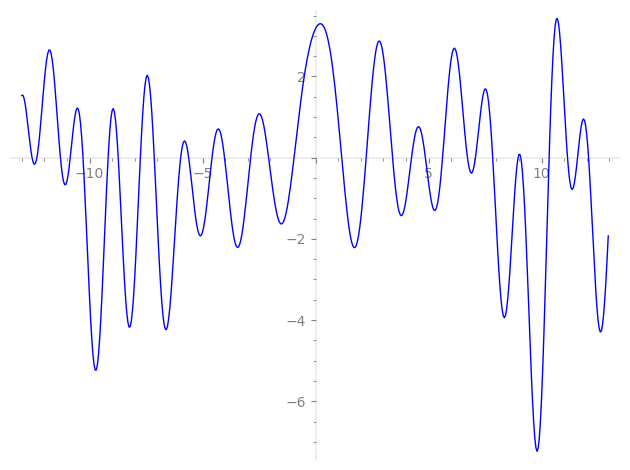| L(s) = 1 | + (0.866 − 0.5i)2-s + (0.499 − 0.866i)4-s + (2.34 + 1.22i)7-s − 0.999i·8-s + (2.03 + 1.17i)11-s − 4.64i·13-s + (2.64 − 0.107i)14-s + (−0.5 − 0.866i)16-s + (−2.28 + 3.95i)17-s + (0.491 − 0.283i)19-s + 2.35·22-s + (5.04 − 2.91i)23-s + (−2.32 − 4.02i)26-s + (2.23 − 1.41i)28-s − 2.55i·29-s + ⋯ |
| L(s) = 1 | + (0.612 − 0.353i)2-s + (0.249 − 0.433i)4-s + (0.885 + 0.464i)7-s − 0.353i·8-s + (0.615 + 0.355i)11-s − 1.28i·13-s + (0.706 − 0.0287i)14-s + (−0.125 − 0.216i)16-s + (−0.553 + 0.958i)17-s + (0.112 − 0.0650i)19-s + 0.502·22-s + (1.05 − 0.607i)23-s + (−0.455 − 0.789i)26-s + (0.422 − 0.267i)28-s − 0.474i·29-s + ⋯ |
\[\begin{aligned}\Lambda(s)=\mathstrut & 3150 ^{s/2} \, \Gamma_{\C}(s) \, L(s)\cr =\mathstrut & (0.705 + 0.708i)\, \overline{\Lambda}(2-s) \end{aligned}\]
\[\begin{aligned}\Lambda(s)=\mathstrut & 3150 ^{s/2} \, \Gamma_{\C}(s+1/2) \, L(s)\cr =\mathstrut & (0.705 + 0.708i)\, \overline{\Lambda}(1-s) \end{aligned}\]
Particular Values
| \(L(1)\) |
\(\approx\) |
\(3.177927050\) |
| \(L(\frac12)\) |
\(\approx\) |
\(3.177927050\) |
| \(L(\frac{3}{2})\) |
|
not available |
| \(L(1)\) |
|
not available |
\(L(s) = \displaystyle \prod_{p} F_p(p^{-s})^{-1} \)
| $p$ | $F_p(T)$ |
|---|
| bad | 2 | \( 1 + (-0.866 + 0.5i)T \) |
| 3 | \( 1 \) |
| 5 | \( 1 \) |
| 7 | \( 1 + (-2.34 - 1.22i)T \) |
| good | 11 | \( 1 + (-2.03 - 1.17i)T + (5.5 + 9.52i)T^{2} \) |
| 13 | \( 1 + 4.64iT - 13T^{2} \) |
| 17 | \( 1 + (2.28 - 3.95i)T + (-8.5 - 14.7i)T^{2} \) |
| 19 | \( 1 + (-0.491 + 0.283i)T + (9.5 - 16.4i)T^{2} \) |
| 23 | \( 1 + (-5.04 + 2.91i)T + (11.5 - 19.9i)T^{2} \) |
| 29 | \( 1 + 2.55iT - 29T^{2} \) |
| 31 | \( 1 + (1.89 + 1.09i)T + (15.5 + 26.8i)T^{2} \) |
| 37 | \( 1 + (4.63 + 8.02i)T + (-18.5 + 32.0i)T^{2} \) |
| 41 | \( 1 - 8.68T + 41T^{2} \) |
| 43 | \( 1 - 6.57T + 43T^{2} \) |
| 47 | \( 1 + (-3.15 - 5.46i)T + (-23.5 + 40.7i)T^{2} \) |
| 53 | \( 1 + (-10.5 - 6.07i)T + (26.5 + 45.8i)T^{2} \) |
| 59 | \( 1 + (-1.67 + 2.90i)T + (-29.5 - 51.0i)T^{2} \) |
| 61 | \( 1 + (6.85 - 3.95i)T + (30.5 - 52.8i)T^{2} \) |
| 67 | \( 1 + (2.00 - 3.46i)T + (-33.5 - 58.0i)T^{2} \) |
| 71 | \( 1 + 2.02iT - 71T^{2} \) |
| 73 | \( 1 + (7.11 + 4.10i)T + (36.5 + 63.2i)T^{2} \) |
| 79 | \( 1 + (-4.13 - 7.15i)T + (-39.5 + 68.4i)T^{2} \) |
| 83 | \( 1 + 0.171T + 83T^{2} \) |
| 89 | \( 1 + (2.72 + 4.72i)T + (-44.5 + 77.0i)T^{2} \) |
| 97 | \( 1 + 10.8iT - 97T^{2} \) |
| show more | |
| show less | |
\(L(s) = \displaystyle\prod_p \ \prod_{j=1}^{2} (1 - \alpha_{j,p}\, p^{-s})^{-1}\)
Imaginary part of the first few zeros on the critical line
−8.730901496082647157888909113755, −7.75173876138902512185923493467, −7.13553852893532735878815792107, −5.96866467998547943495608532785, −5.61341098735552898070788663467, −4.58173645591170714487262958108, −4.02712450805482014289543777533, −2.87263111054360904000098397416, −2.07854064124657217364919855209, −0.952507146783937178262348253080,
1.15769551432101906697641085850, 2.23863401983396724805896293634, 3.40640453091644541147186319662, 4.24514275232284722371712140867, 4.85969734489993244424714457465, 5.61876625987502422858987467935, 6.72022467783895115837833436862, 7.07361539265510294102208366460, 7.83808208993057779703905695375, 8.959654314683990176296792240099

